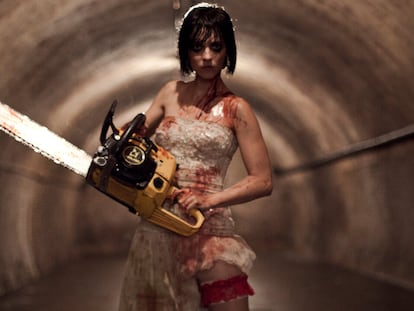‘They didn’t know what to do with me’: The return of Linda Hamilton, action film star who survived ‘Terminator,’ drugs and depression
The actress, who is the unmistakable face of the Schwarzenegger saga, is back in the limelight after her role in the latest season of ‘Stranger Things’ was confirmed
She has been played by Game of Thrones stars such as Emilia Clarke and Lena Headey, but for diehard fans of the Terminator saga, the real Sarah Connor will always be actress Linda Hamilton (Maryland, 66 years old). Hamilton is the soul of the pre-apocalyptic heroine, an undisguised Virgin Mary who is more furious than pious and instead of turning the other cheek, reloads the bazooka. The role earned her a permanent place in popular culture and could have made her a bigger star, but her path was strewn with addictions through which she sought to hide a permanent state of anger, sadness and dissatisfaction, and it took years before she received a bipolar disorder diagnosis. Once again, she is back in the limelight after being cast in Stranger Things. The series is a vessel for eighties nostalgia that has already revived the likes of Sean Astin (The Lord of the Rings), Cary Elwes (The Princess Bride, Saw) and Robert Englund (Freddy Krugger in Nightmare on Elm Street).
“I was going to be a Shakespearean actress, but everything changed with Terminator,” said Hamilton in an interview a few years back. Following an erratic youth spent trying to channel her energy through acting, she relocated to New York and studied with the prestigious Lee Strasberg, who taught Marlon Brando and James Dean. It was an acting school that provided no indication that her success would come from horror and science fiction productions. In 1984 she starred in two films that would place her on the map: the adaptation of Stephen King’s novel Children of the Corn and what initially seemed like a B-movie eccentricity from a young, unknown director named James Cameron, The Terminator. When she received the script about a waitress and a time traveler on the run from a merciless robot, she accepted it because she had no other offers on the table. However, Cameron had been so impressed with her audition that he modified the character’s age from 19 to 27 to fit Hamilton’s profile.
She had minimal expectations for the project, the budget was shoestring, almost everyone involved was a rookie and the best-known face was that of “a bodybuilder pretending to be an actor.” Or at least that’s what she thought of Schwarzenegger before she met him, according to her own account in the Arnold (2023) documentary: “Because I was curious, I went over to say hello. When I saw the physicality and the stiffness and all of the things that he was implementing, I was like, ‘OK, this might work.’” The shoot was strenuous, they worked day and night and Hamilton would spend much of her role either cowering or on the run. “It was hard psychologically. When I finished filming, I was still dreaming about the Terminator.” Against all odds, that low-budget film was a resounding success with critics and audiences alike.
Linda left behind as co-stars flourish
Yet while Cameron’s and Schwarzenegger’s careers flourished, Hamilton failed to attract interesting offers. Her most successful role following The Terminator came in a television series, Beauty and the Beast (1987), a modern reinterpretation of the classic crime thriller (with Belle as an assistant district attorney in Manhattan) produced and co-written by George R.R. Martin. Hamilton and Ron Perlman made up one of America’s favorite TV couples until she left the series after becoming pregnant by her first husband, Re-Animator star Bruce Abbott.

During that interval, she received an unexpected call. Seven years after the first film, James Cameron had decided to make a second part of The Terminator and wanted her to be involved. Hamilton set two conditions for her acceptance: the first was obviously that she needed to recover from her pregnancy; the second was that Sarah Connor should not be a damsel in distress, but a relentless fighter. “I wrote it based on her instructions,” admitted James Cameron. Sarah Connor shifted from running from danger to confronting it head on. At that time, Bruce Abbott had filed for divorce, and she saw the role as an opportunity to vent the pain she was going through. “I just needed to get up on my feet and be strong and do nothing but mother my child and get ready for this film,” Hamilton said. “To give myself permission to be that powerful, strong woman was necessary for my survival.” Despite criticism after the premiere focusing on the mastery of special effects that were unheard of at the time (it was then the most expensive production in the history of cinema), for many people, her portrayal of a mother tormented by an apocalyptic future became the centerpiece of the film.
“Linda Hamilton has received very little recognition over the years for the large part of the film that is based on her,” wrote the film critic Justin Clark years later. Terminator 2: Judgment Day (1991) was the year’s top-earning film and once again charmed the critics. Cameron suggested that Hamilton reinvent herself as “a female Bruce Willis,” but she was keen to do comedy. It didn’t take long for her to realize that her profile was spooking the producers: “They thought I was going to eat them alive, they didn’t know what to do with me.” She didn’t make it easy on herself either. “My answer to being that ‘overnight success’ was to go and get pregnant with Jim [Cameron] and completely disappear. What timing!”
Hitting the iceberg
The actress and director had fallen in love during the filming of the sequel, a love affair that overlapped with the collapse of the marriage between Cameron and fellow director Kathryn Bigelow. This proved to be a tumultuous relationship, fraught with arguments, until it ended when they collided into a giant iceberg: Titanic (1997). Following the previous pattern, the filmmaker fell in love with actress Suzy Amis, who played Gloria Stuart’s granddaughter in the film. It was a brief but definitive role in Cameron’s private life and Hamilton was not caught by surprise: “Work and women go hand in hand for Jimbo, and I should know.” But she doesn’t put their split down to that affair. “Titanic was the most painful thing in the world. But this wasn’t because Jim was cheating on me. Jim went off with Suzy because we were taking a break from each other and he was free to go with her.” After the fling, Cameron and Hamilton got back together and married, but two years later the director returned to Amis and filed for divorce from his wife. The emotional seesaw of Hollywood’s box-office king thrilled the tabloids. The separation made headlines and resulted in a record $50 million settlement for Hamilton.

“I was completely devastated for years, but I’m so glad to be free of that. I would never, ever put that much energy again into something that is not working,” she reflected in 2019, when she also acknowledged that she had not been in a relationship for several years. “I’ve been celibate for at least 15 years. One loses track, because it just doesn’t matter.” She says her relationship with Cameron failed because he “fell in love with Sarah Connor,” instead of with her. A cry echoing Rita Hayworth’s regret 50 years earlier: “Men go to bed with Gilda, but wake up with me.”
The other reason, her mental health problems, also accounted for her struggles in redirecting an increasingly erratic career. “I had depression since I was a child, but no one noticed it and even I didn’t know what it was in those days. I just felt different,” she told TV host Larry King in 2005. The death of her father when she was 5 years old was a bitter pill to swallow. She claimed that she had a happy childhood, but, at the same time, she experienced outbursts of unwarranted anger. When she entered high school, she became self-marginalized and began to binge eat. She first saw a psychologist at the age of 22 and thought acting would help her feel better, but the profession made it all worse. “I really started to break down,” she revealed to Oprah Winfrey. “I turned to drugs. Alcohol use. I medicated with lots of cocaine in my early life. Anything that I could do to get my confidence up.”
It was these underlying problems that also led to the end of her first marriage to Bruce Abbott. “He lived in fear of me. He left me saying I was a bully.” For a year, she barely said a word to her then husband, locking herself in her room to read science fiction books. The call to work on The Terminator sequel came just when she felt she had lost control of her life and the experience helped her to deal with her addictions. “It could not have been better timing for me to get up every morning and get out there and exercise and start to feel stronger and turn myself into this fighting machine. So of course, I went too far with the exercise.”
After the birth of her second child, she began having hallucinations. She experienced postpartum depression that was “very much like a psychosis.” “I couldn’t leave the house without images of them [her children] being chopped into bloody pieces. I had visions.” More than a dozen nannies passed through her home, but Hamilton felt that she was the only one who could protect them. She wanted to isolate herself but, at the same time, she didn’t want to leave her children alone. “I had two small children and couldn’t get up at night to put them to bed.” That was the catalyst for her to accept that she needed more than just sport. After years of denial, she agreed to use medication. “It’s taken me a long time to get my life back. To be the person I was raised to be,” she admitted.

Hamilton was not fond of fame or the hustle and bustle of Hollywood, and she traded Los Angeles for a ranch in Virginia where she relocated to take care of her mother and stepfather. When they passed away, she moved to New Orleans. Since her participation in Dante’s Peak (1997), she was not involved in major productions for 20 years, confining her appearances to smaller projects or series such as Chuck (2007) and Weeds (2005). At this point, she received another unexpected call from James Cameron, who offered her the chance to play Sarah Connor again, but she was hesitant to accept. “It’s not that I was afraid to let the fans down, I was afraid to let Sarah Connor down.” She went back to training in her late sixties. “I put in 10 times the effort than in the second film,” she said. She tried to make her body appear believable, but did not care about a face that reflected all of Connor’s suffering, much like that of Linda’s.
Terminator: Dark Fate (2019) proved not to be a huge success. Produced by James Cameron and directed by Tim Miller, who had major and public disagreements with the creator of the saga during the production process (he even called it a “trauma”), the sequel narratively omitted the existence of the three post-1991 releases with the aim of recapturing the spirit of the original two films. It was a far cry from being a match, but at least it did serve to demonstrate to audiences around the world that Linda Hamilton was still alive and kicking, and not just in a physical sense.
Sign up for our weekly newsletter to get more English-language news coverage from EL PAÍS USA Edition
Tu suscripción se está usando en otro dispositivo
¿Quieres añadir otro usuario a tu suscripción?
Si continúas leyendo en este dispositivo, no se podrá leer en el otro.
FlechaTu suscripción se está usando en otro dispositivo y solo puedes acceder a EL PAÍS desde un dispositivo a la vez.
Si quieres compartir tu cuenta, cambia tu suscripción a la modalidad Premium, así podrás añadir otro usuario. Cada uno accederá con su propia cuenta de email, lo que os permitirá personalizar vuestra experiencia en EL PAÍS.
¿Tienes una suscripción de empresa? Accede aquí para contratar más cuentas.
En el caso de no saber quién está usando tu cuenta, te recomendamos cambiar tu contraseña aquí.
Si decides continuar compartiendo tu cuenta, este mensaje se mostrará en tu dispositivo y en el de la otra persona que está usando tu cuenta de forma indefinida, afectando a tu experiencia de lectura. Puedes consultar aquí los términos y condiciones de la suscripción digital.
More information
Archived In
Últimas noticias
Venezuelan exiles in Madrid scramble to salvage Christmas plans after flight cancellations
Russian ultranationalism, inflamed by the killing of the hooligan commander ‘Spaniard’
The relentless struggle between factions deepens the Sinaloa war: bodies in coolers and a surge in homicides
‘Doctor Death’, the journalist who has witnessed 105 executions in Florida
Most viewed
- The low-cost creative revolution: How technology is making art accessible to everyone
- Christian Louboutin: ‘Young people don’t want to be like their parents. And if their parents wear sneakers, they’re going to look for something else’
- All the effects of gentrification in one corner of Mexico’s Colonia Roma
- Liset Menéndez de la Prida, neuroscientist: ‘It’s not normal to constantly seek pleasure; it’s important to be bored, to be calm’
- Christmas loses its festive spirit: ICE fears cast shadow over religious celebrations












































